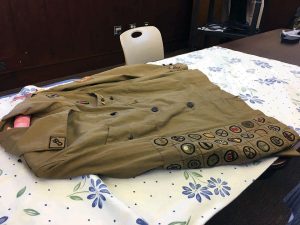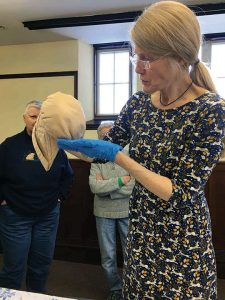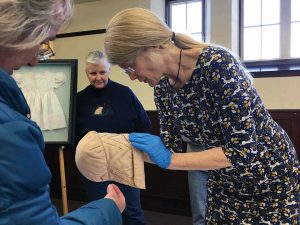It is an art form that incorporates history, chemistry, crafting, and the ability to know the difference between good dirt and bad. It is a career path that can take the student from academic studies of ancient people to the closets of contemporary kings and queens. And for one Rochester resident, it has been a life’s passion of study and applied techniques of textiles.
On Sunday, March 18, Kathryn S. Tarleton shared her experiences as a textile conservationist in a presentation given at the Mattapoisett Free Public Library. Tarleton, along with her business partner Charlotte Hamlin, provide the delicate service and sometimes forensic work of preserving and conserving historic textiles.
“It is really a disparate group of materials that together make up a textile,” said Tarleton.
Throughout man’s evolution, textiles have been used to clothe bodies, carry supplies, or make life more comfortable as blankets and quilts.
Tarleton pulled back the curtain so to speak on the role of a textile conservator in both private and public settings. She began with textiles made of organic fibers, such as animal hair and hides. And while early textiles contained natural fibers, the 20th century brought synthetic fibers into the picture changing the very chemicals that make up fibers.
Tarleton explained that her work has included cleaning fabrics, maintaining them, and preparing them for exhibitions, or a combination of these that may be singular or involve one or more skill-sets.
It became apparent during her talk that a conservator’s role is a very critical area of expertise necessary to ensure that our historic pieces survive as long as possible.
Tarleton has worked for the Smithsonian, Brown University, Rhode Island School of Design, Peabody Essex Museum, Tufts University and more recently the New Bedford Whaling Museum to name a few.
Textile conservation, Tarleton said, requires that the fabric be studied to determine just what its needs might be, whether it be restoring it to its original state or stabilizing it from further deterioration.
Through the review process, the conservator will produce a report on the current state of the item in question along with recommendations that may or may not include cleaning. It is interesting to note that a conservationist uses vacuuming to remove surface impurities that can include everything from household dust to insect body parts.
Tarleton drew the curtain back even further on the types of methods used by conservators when she displayed a photograph of a 19th-century dress before and after preservation. The dress had been on exhibit for some years without the proper supports, thus tearing and straining of the delicate old fabric and seams had brought on a great deal of deterioration. After a wooden loop frame constructed in the style of the period and proper mannequin were used to provide the correct support to the dress, it looked radically improved – like a facelift only without the telltale tucks.
Another fascinating set of images showed a very sad and sagging discolored wedding dress from 1840. After careful cleaning and proper support, the Flemish needle lace on silk garment appeared as crisp and bright as the day that long-ago bride had worn it.
But the most surprising item Tarleton displayed in photographs was a Union soldier’s cap from the Civil War. It had been almost completely consumed by insects and crushed due to the lack of supports. The cap was all but gone. After conservators built a support, the delicate work of applying the remaining fabric bits and pieces to the lining ensued. The finished product was a cap that was significantly returned to an original appearance without sacrificing what remained of the original wool and leather pieces. It is now on exhibit.
The audience was invited to show Tarleton some of their own historic pieces and to ask questions on how best to preserve and conserve them.
There was a 19th-century lady’s bonnet, a 1940s Girl Scout blouse, a baby’s christening gown, and an oriental silk-on-silk embroidered pillowcase. Tarleton apprised the owners of the best course of action with each as she studied the pieces with a reverence honed from years of understanding the importance of historic materials to the human experience. Tarleton said documenting the history of their pieces was necessary to maintaining their provenance.
“It doesn’t have to be technical, but write down the history of the object: who, what, when, where. That’s part of its personal history,” Tarleton said. Absent that, she added, the piece would likely have diminished value. She also told them to avoid wet cleaning. “The stain probably won’t come out anyway…” and to use acid-free storage boxes and tissue paper and to never let fabrics rest against bare wood, such as cedar chests.
One final word on what not to do: “Don’t use moth balls!”
Mothballs do little to keep insects away, she said, and are carcinogenic, and therefore harmful to people. “The best thing is good housekeeping,” Tarleton said with a smile.
She also recommended keeping historic textiles in rooms where temperatures remained around 70 degrees and maintained a humidity of about 50 percent year round.
When asked what her most challenging conservation project has been, Tarleton quickly responded, “The panorama I’m working on for the New Bedford Whaling Museum.”
The 8.5-foot by 1,300-foot piece of cotton muslin depicts a worldwide whaling voyage. The mammoth artwork is being prepared for a spring exhibition.
If you have questions about your historic fabrics or textiles, you may find answers at www.conservation-us.org, the Smithsonian Museum Conservation Institute, the Textile Museum www.museum.gwu.edu/textiles-care, or by contacting Tarleton or Hamlin at info@contextinc.net.
By Marilou Newell


